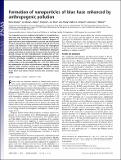| dc.contributor.author | Zhang, Renyi | |
| dc.contributor.author | Wang, Lin | |
| dc.contributor.author | Khalizov, Alexei F. | |
| dc.contributor.author | Zhao, Jun | |
| dc.contributor.author | Zheng, Jun | |
| dc.contributor.author | McGraw, Robert L. | |
| dc.contributor.author | Molina, Luisa Tan | |
| dc.date.accessioned | 2010-09-17T13:51:00Z | |
| dc.date.available | 2010-09-17T13:51:00Z | |
| dc.date.issued | 2009-10 | |
| dc.date.submitted | 2009-05 | |
| dc.identifier.issn | 0027-8424 | |
| dc.identifier.uri | http://hdl.handle.net/1721.1/58580 | |
| dc.description.abstract | The molecular processes leading to formation of nanoparticles of blue haze over forested areas are highly complex and not fully understood. We show that the interaction between biogenic organic acids and sulfuric acid enhances nucleation and initial growth of those nanoparticles. With one cis-pinonic acid and three to five sulfuric acid molecules in the critical nucleus, the hydrophobic organic acid part enhances the stability and growth on the hydrophilic sulfuric acid counterpart. Dimers or heterodimers of biogenic organic acids alone are unfavorable for new particle formation and growth because of their hydrophobicity. Condensation of lowvolatility organic acids is hindered on nano-sized particles, whereas ammonia contributes negligibly to particle growth in the size range of 3–30 nm. The results suggest that initial growth from the critical nucleus to the detectable size of 2–3 nm most likely occurs by condensation of sulfuric acid and water, implying that anthropogenic sulfur emissions (mainly from power plants) strongly influence formation of terrestrial biogenic particles and exert larger direct and indirect climate forcing than previously recognized. | en_US |
| dc.description.sponsorship | Robert A. Welch Foundation (A-1417) | en_US |
| dc.description.sponsorship | National Natural Science Foundation (China) (40728008) | en_US |
| dc.description.sponsorship | Department of Energy Atmospheric Sciences Program | en_US |
| dc.language.iso | en_US | |
| dc.publisher | National Academy of Sciences | en_US |
| dc.relation.isversionof | http://dx.doi.org/10.1073/pnas.0910125106 | en_US |
| dc.rights | Article is made available in accordance with the publisher's policy and may be subject to US copyright law. Please refer to the publisher's site for terms of use. | en_US |
| dc.source | PNAS | en_US |
| dc.subject | aerosol | en_US |
| dc.subject | biogenic | en_US |
| dc.subject | climate | en_US |
| dc.subject | nucleation | en_US |
| dc.subject | forest | en_US |
| dc.title | Formation of nanoparticles of blue haze enhanced by anthropogenic pollution | en_US |
| dc.type | Article | en_US |
| dc.identifier.citation | Renyi Zhang, Lin Wang, Alexei F. Khalizov, Jun Zhao, Jun Zheng, Robert L. McGraw, and Luisa T. Molina (2009). Formation of nanoparticles of blue haze enhanced by anthropogenic pollution. PNAS 106: 17650-17654. ©2009 by the National Academy of Sciences | en_US |
| dc.contributor.department | Massachusetts Institute of Technology. Department of Earth, Atmospheric, and Planetary Sciences | en_US |
| dc.contributor.approver | Molina, Luisa Tan | |
| dc.contributor.mitauthor | Molina, Luisa Tan | |
| dc.relation.journal | Proceedings of the National Academy of Sciences of the United States of America | en_US |
| dc.eprint.version | Final published version | en_US |
| dc.identifier.pmid | 19815498 | |
| dc.type.uri | http://purl.org/eprint/type/JournalArticle | en_US |
| eprint.status | http://purl.org/eprint/status/PeerReviewed | en_US |
| dspace.orderedauthors | Zhang, R.; Wang, L.; Khalizov, A. F.; Zhao, J.; Zheng, J.; McGraw, R. L.; Molina, L. T. | en |
| dc.identifier.orcid | https://orcid.org/0000-0002-3596-5334 | |
| mit.license | PUBLISHER_POLICY | en_US |
| mit.metadata.status | Complete | |
